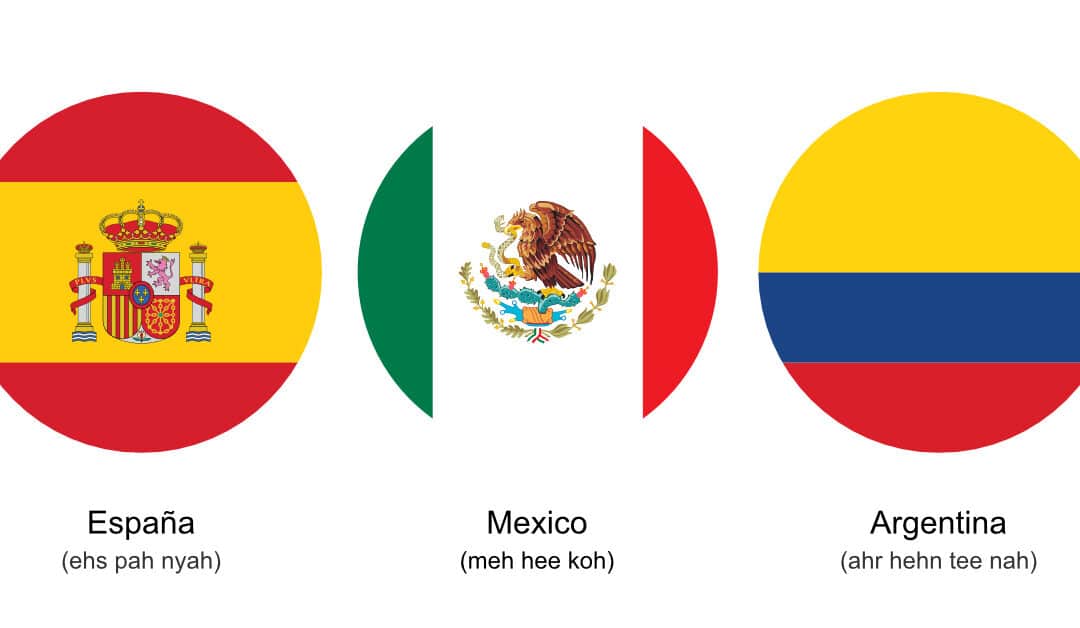It’s geography time! Wait a second, isn’t this a Spanish as a second language blog?
Well, yes! But who says both subjects don’t go together? They do! Oftentimes, when we think about learning Spanish we think about grammar and reading comprehension exercises. Though that is important, it’s also important to learn vocabulary about different things we interact with every day, like other countries. So, a small geography lesson to learn the names and how to pronounce other countries’ names in Spanish is well received.
If your kids are learning Spanish, they should start learning the Spanish pronunciation of different countries now. What if they travel abroad? What if they have the opportunity to do an exchange program in a Spanish speaking country? Or what if they make Hispanic friends? To help them out, TruFluency Kids presents a guide to learn the names and Spanish pronunciation of different countries.
Spanish Names & Pronunciation of all the Hispanic Countries
Spanish is the official language in 21 countries around the world. Here are the names of those countries in Spanish plus the pronunciation according to Span¡shD!ctionary.
- Spain – España (ehs pah nyah)
- Equatorial Guinea – Guinea Ecuatorial (gee neh ah / eh kwah toh ryahl)
- Mexico – México (meh hee koh)
- Guatemala – Guatemala (gwah teh mah lah)
- El Salvador – El Salvador (el / sahl bah dohr)
- Honduras – Honduras (ohn doo rahs)
- Nicaragua – Nicaragua (nee kah rah gwah)
- Costa Rica – Costa Rica (kohs tah rree kah)
- Panama – Panamá (pah nah mah)
- Colombia – Colombia (koh lohm byah)
- Ecuador – Ecuador (eh kwah dohr)
- Peru – Perú (peh roo)
- Bolivia – Bolivia (boh lee byah)
- Chile – Chile (chee leh)
- Argentina – Argentina (ahr hehn tee nah)
- Uruguay – Uruguay (oo roo gwahee)
- Paraguay – Paraguay (pah rah gwahee)
- Venezuela – Venezuela (beh neh sweh lah)
- Puerto Rico – Puerto Rico (pwehr toh / rree koh)
- Dominican Republic – República Dominicana (rreh poo blee kah / doh mee nee kah nah)
- Cuba – Cuba (koo bah)
Spanish Names & Pronunciations of Different Countries
Now you know the names of all the 21 official Spanish-speaking countries. But here are the names in Spanish of different countries that aren’t Hispanic. Some of them have a large Spanish-speaking population and some others have a language similar to Spanish.
Even if a country is not close to the Spanish language, it’s good that kids know their Spanish names when learning the language.
- United States – Estados Unidos (ehs tah dohs / oo need dohs)
- The Philippines – Filipinas (fee lee pee nahs)
- Brazil – Brasil (brah seel)
- Belize – Belice (beh lee seh)
- Canada – Canadá (kah nah dah)
- Andorra – Andorra (ahn daw ruh)
- Portugal – Portugal (pohr too gahl)
- Italy – Italia (ee tah lyah)
- France – Francia (frahn syah)
- Romania – Rumania (rroo mah nyah)
- Haiti – Haití (ay tee)
- Morocco – Marruecos (mah rrweh kohs)
- Algeria – Argelia (ahr heh lyah)
- Sweden – Suecia (sweh syah)
- England – Inglaterra (eeng glah teh rrah)
- Australia – Australia (ows trah lyah)
- Switzerland – Suiza (sooee sah)
- Greece – Grecia (greh syah)
- Japan – Japón (hah pohn)
- Netherlands – Países Bajos (pah ee sehs / bah hohs)
TruFluency Kids Make Your Kids Masters of the Spanish Language & Culture
If you want your kids to keep immersing themselves in the Spanish language and cultures, they’ll need the proper guide. We’re talking about a bigger guide than this blog. That is someone to teach them all kinds of Spanish vocabulary – maybe more countries in Spanish – idioms, listening, reading, writing. And even better, the culture of Hispanic countries. That will make your children masters of Spanish.
If that’s what you wish for your children, the TruFluency Kids is your best guide. We offer online classes with native teachers that will help your children learn but especially have fun. Teachers will also make sure they learn about the cultures of the Spanish-speaking countries. There’s so much to learn and love about them!
This way, students will enjoy attending classes and will fall in love with the language.
Our Bellieu Method is the best tool to make all of that happen. This is an immersion learning method. That means that we create a complete Spanish environment in every class, there’s barely any English. Part of this method also consists of learning through fun, everyday activities, like singing in Spanish, cooking, crafting, and playing games. So your kids will acquire the language just like they acquired their mother tongue.
We also focus even more on speaking practice. So your children can become fluent in Spanish as soon as possible. Who knows? Maybe next time you go to a Hispanic country, they’ll be the ones translating a lot of things for you.
Sign up your kids for our next session and see for yourself how much they’ll learn. Or take a trial class first.


